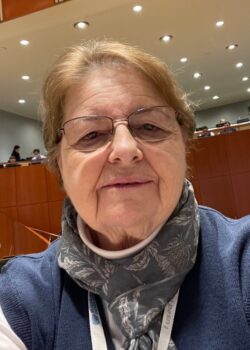November, 2023 Monthly Reflection
November 1, 2023Human trafficking and migration—Contemporary forms of slavery
Sister Michelle Loisel, DC
Global Estimates of Modern Slavery demonstrates that migrant workers are three times more likely to end up in forced labor exploitation in the private sector, than local workers. Migrants are also particularly vulnerable to trafficking on their migration journey.
While migration, smuggling and trafficking are separate phenomena, they are closely linked. However, we must admit that strengthening the understanding of migrants’ trafficking: trafficking of migrants is still too often confused with other crimes, especially migrant smuggling.
When immigration laws do not support the movement of people through legal means, people can be forced to take irregular routes – which might rely on people smugglers and sometimes people traffickers – making them more vulnerable to modern slavery. We know that traffickers lure victims by promising safe travel and entry into the desired country, and then deceive them into exploitative situations. Global crises, conflicts, and the climate emergency are escalating trafficking risks. People lacking legal status living in poverty and without decent work often become the primary targets of traffickers. Women migrate for diverse reasons: from leaving behind poverty, conflict, and climate-related disasters to escaping deeply entranced gender inequalities, including sexual and gender-based violence and lack of access to livelihoods and resources. https://interactive.unwomen.org/multimedia/explainer/migration/en/index.html
I have in mind the tragedy of the Darien Gap, a wild, lawless stretch of all straddling Colombia and Panama, a trail used by migrants as a last resort, in the hope of one day reaching the US border. Each migrant represents a life with great hardship. During the day’s long trek through the jungle, children and families are exposed to multiple forms of violence, including sexual abuse, trafficking, and exploitation.
According to the 2022 World Migration Report (with data from the UN Office on Drugs and Crime) 45% of all identified victims of trafficking had been trafficked across international borders. Migrants can be vulnerable both to being trafficked internationally and domestically – as they may be trafficked domestically after arriving in a country.
What are we doing about it? Hundreds of thousands of migrants are crossing into the country every day. Human trafficking has become one of the largest issues facing our border security, with men, women, and children being exploited and forced into labor against their will. Considered the modern form of slavery, human trafficking has become one of the world’s most lucrative businesses, bringing in an estimated $150 billion annually for evil predators.
Alliance to End Human Trafficking (AEHT) and the National Advocacy Center of the Sisters of the Good Shepherd (NAC) have embarked on a months-long journey of listening, analysis and action to address the dangerous nexus between forced migration and human trafficking. On Nov. 6, constituents from AEHT, and NAC will meet with members of Congress and staff to break the link between human trafficking and forced migration by addressing the root causes of forced migration, reducing delays in work permits for asylum applicants, and protecting unaccompanied children. Both organizations share a commitment to ending human trafficking and supporting survivors. Learn more: https://alliancetoendhumantrafficking.org/human-trafficking-and-forced-migration/ and sign up for our action alerts to get the latest updates in the fight against human trafficking.

Michelle Loisel, DC
Category: Monthly Reflections, The Alliance to End Human Trafficking

